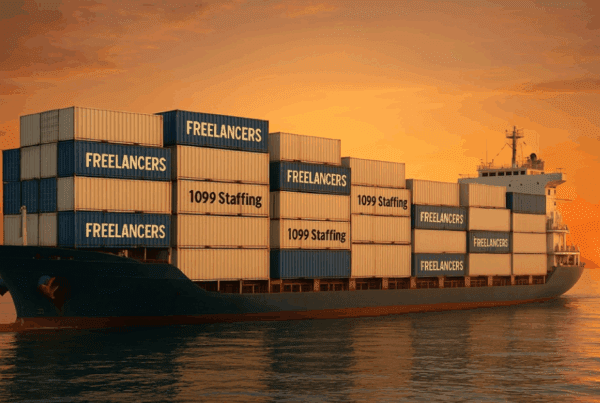
These days, freelancers know what they want, and they’re not afraid to hold out until they get it.
The global pandemic changed everything for the freelance workforce. After years of watching full-time employees own the limelight, massive layoffs and smaller budgets kicked the attention back to freelancers, given their agility and deeply skilled backgrounds. This changed things for businesses, big time: No longer was the hiring process a spray-and-pray situation — they had no other choice but to welcome freelancers and give in to their demands.
For decades, freelancers were thought to mainly function as skilled workers who often partnered with agencies to complete creative work or clients who handled one-off projects. However, as a result of the global pandemic and resulting labor shortages, companies were forced to turn to the growing freelance workforce to help smaller, core teams keep up with demand, bringing freelancers further into the corporate world than ever before.
Since 2019, the share of independent professionals who earn a living freelancing full-time has increased eight percentage points to 36%, according to a study conducted by Upwork. In 2021, Statista found there are almost 68 million freelancers in the workforce — an agile workforce ready to be utilized by the business landscape to supplement the current talent shortages. But to harness the power of freelancers, employers first need to understand how to attract them.
Flexibility, Flexibility, Flexibility
Flexibility has been quite the debate between the worker and workplace in the past year: A 2021 survey conducted by Microsoft found that 70% of workers want flexible, remote options moving forward. And although freelancers often embody flexibility, they’re among the masses wanting to be guaranteed the offer of flexibility within their contract.
In a survey conducted in 2021 by my company, 25% of freelance respondents said flexibility is their favorite element of freelancing. The number one rule for attracting freelancers is to avoid confining them to 9-5 workdays. Although internal employees may work those hours, freelancers are likely working for a few clients at any given time and can’t (and don’t want to) commit to typical hours.
Flexibility doesn’t have to mean encouraging work at all hours of the day: It can be as simple as offering expectations for communication. For example, which channels will be used and when — always with the understanding that the freelancer may not always be available to answer right away or hop on a last-minute call. That’s freedom, baby.
Welcome Them In
One of perhaps the most difficult and frustrating aspects of freelancing can be feeling disconnected from the team or client they’re working with. It’s incredibly important to address these issues even before hiring a freelancer, as communication and a partnership mentality can make or break the entire job.
In a UK survey conducted in 2020, 6 out of 10 freelancers reported they regularly feel lonely due to the nature of their work. On top of feeling isolated, 62% of respondents also said they feel stressed due to their work. This data reveals that one of the most important things an employer can do to attract freelancers is to pay special attention to how they integrate external talent. Building a strong culture is one feat, but creating one that also helps freelancers feel included requires another layer of community to build — and it’s not just a responsibility of leadership, but of employees, too.
One of the best ways to create an inviting atmosphere for freelancers is by ensuring they know their voice is heard and their opinion is respected by their team — especially leadership. Regularly invite them to team meetings and ensure they get the chance to speak up regarding decisions; they are highly skilled and experienced in their domain, after all.
Additionally, invite them to team-bonding activities, virtual or in-person, to help employees get to know their freelance coworkers better and build relationships. Although in-office work is not possible for every company, if there is a physical office, make sure the freelance team knows they are welcome to visit and utilize the space anytime they wish.
Offer Dependable Pay — And Stick To It
According to a 2021 survey (registration required) by my company, the top two reasons freelancers leave freelancing is unstable income and a lack of available projects. Unfortunately, these issues have haunted freelancers for years and contribute to the idea of the “starving freelancer” — an independent worker who is continuously forced to chase after new work just to pay the bills.
Although this idea doesn’t in any way paint the proper picture of what it means to be a freelancer, developing a continuous pipeline of projects that pays the bills isn’t easy.
That being said, one of the most important aspects to offer a freelancer is a dependable income that is consistently paid on time. While this may seem obvious to some, many freelancers have encountered clients who make them chase down payments and invoices regularly, making it that much more exhausting to even think of taking on another.
Freelancers work just the same as employees and use the same effort, if not more, to achieve outcomes, and they deserve the same treatment regarding pay. If you don’t have the resources to pay your freelancers on time, you can consider utilizing a talent platform that will take care of the billing for you. (Full disclosure: My company specializes in connecting freelancers and employers.)
Most importantly, no matter the strategy you decide to use to pay your freelancers, always discuss how payment is done ahead of the contract and stick to it. Freelancers will greatly appreciate the upfront transparency, and your talent retention will benefit from it.
Attracting elite freelancers isn’t as easy as simply posting a job — and the benefits offered to full-time employees won’t do the trick, either. In an age where workers are gaining more control at a rapid pace, employers need to have a keen sense of how to attract independent workers — and their decisions will largely impact their agility in the years to come.
FlexTal is the #1 flexible talent matching platform. Every day, we match organizations with pro-level independent contractors for flexible hourly and project-based engagements. Match with the Right Pro, Right Now.



